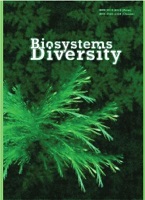Age estimation of black locust (Robinia pseudoacacia) based on morphometric traits
Age estimation of black locust (Robinia pseudoacacia) based on morphometric traits
Author(s): O. M. Kunakh, I. A. Ivanko, K. K. Holoborodko, A. M. Volkova, O. V. ZhukovSubject(s): Agriculture, Energy and Environmental Studies, Methodology and research technology, Environmental interactions
Published by: Дніпропетровський національний університет імені Олеся Гончара
Keywords: reclamation; horticulture; bioenergetic;spatial ecology;regression; biometry;
Summary/Abstract: The use of black locust (Robinia pseudoacacia L.) is still controversial, especially in managed forests, due to its invasive nature. The black locust has been proven effective in reclamation of degraded lands when native species are not an alternative in the face of the climate change and desertification. Therefore, the importance of black locust in European ecosystems remains a matter of debate. Of course, it is an adventitious species originating from another continent. However, the ecological characteristics of the species in its natural range are very useful for ensuring the restoration of vegetation cover in areas that have experienced significant anthropogenic pressure. This species has a large number of important and useful features that make it an important agent in the forestry system and provide significant environmental and economic benefits. The status of black locust as an invasive species, i.e. one that is capable of uncontrolled spread, remains speculative. Such a conclusion requires various studies, including those identifying exact age of the plants based on morphometric parameters. In our study, we tested the hypothesis that plant height and trunk diameter will allow for an accurate assessment of black locust age. The plants of black locust were measured in the zone of spontaneous self-seeding of plants from a planted 60-yearsold forest. The plants dispersed towards a fallow land, formed in the corner of an agricultural field. The spreading began 15 to 20 years ago. The plants are mainly propagated by seedlings. An expert estimated the age of the plants visually. The measured trees were cut to obtain cross sections to account for the number of annual rings. A total of 68 trees were examined for morphometric characters. Black locust communities during self-dispersal are represented by individuals of different ages. The spatial pattern of distribution of individuals of different ages can reveal the spatial and temporal dynamics of the formation of spontaneous populations of black locust. For this purpose, it is critical to accurately identify the age of a large sample. Expert estimation of age is fast and fairly accurate, but it depends greatly on the qualifications of the expert and oftentimes plant ages are underestimated, especially in the early stages of population development. Plant height is also a good predictor of plant age, but the model gives poor predictions for plants older than 10 years. The tree height ranged 2.3 to 16.0 meters. The diameter at breast height (DBH) ranged 1.0 to 17.5 cm. The diameter at the root collar (DRC) ranged 1.6 to 21.7 cm. The age of the studied trees, determined by the number of annual rings per transect, ranged 6 to 17 years. The age of the trees according to the expert estimates was 8.2 ± 4.8 years. The expert estimates of age and the age according to the number of annual rings were statistically significantly different. The expert estimates of tree age were linearly related to tree size, while estimates of the number of annual rings showed a logarithmic relationship with tree height. Expert estimates also showed a closer relationship with tree height, while the relationship of estimates based on the number of annual rings had a slightly lower dependence on the morphometric traits. Regression analysis showed that there is a linear relationship between morphometric traits of the black locust. The coefficient of determination for the dependence of diameter at breast height on tree height was 0.96, and for the dependence of diameter at the base of the trunk on diameter at breast height was 0.97. This indicates a high level of multicollinearity of these morphometric traits when considering them as predictors of plant age. Taking into account the diameter at breast height and the diameter at the level of the root collar significantly improved the predictive ability of the model for identifying the age of the black locust trees.
Journal: Biosystems Diversity
- Issue Year: 31/2023
- Issue No: 2
- Page Range: 222-228
- Page Count: 7
- Language: English

